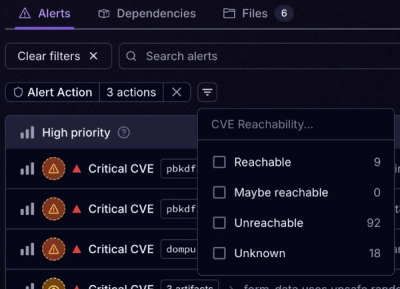
Product
Announcing Socket Fix 2.0
Socket Fix 2.0 brings targeted CVE remediation, smarter upgrade planning, and broader ecosystem support to help developers get to zero alerts.
contiamo-rest-client
Advanced tools
Simple RESTful JS client to interact with nested resources in a given backend.
This REST client attempts to communicate with a backend API, interacting in a declarative way.
First, you'll want to add the contiamo-rest-client to your project like so:
npm install contiamo-rest-client, alternatively
yarn add contiamo-rest-client if you're into yarn.
Then, your code needs a couple of building blocks:
Consider the following REST endpoint:
GET https://api.myapp.com/tenants/123/bundles
The above URL signals two things:
collection of resources available at /tenants.tenant (#123) that we want to retrieve bundles for.Expressed as a blueprint that this client understands, this would look like:
import { TenantCollection, BundleCollection } from "./collections"
export default {
key: 'tenants',
collection: TenantCollection,
path: 'tenants',
children: [
{
key: 'bundles',
collection: BundleCollection,
path: 'bundles',
}
]
}
From the above snippet, we see that the BundlesCollection is a child of TenantsCollection, similar to our URL structure.
But what is TenantsCollection?
Consider:
import {
Collection,
Listable,
Fetchable,
Destroyable,
Resource
} from "contiamo-rest-client"
export class TenantsCollection extends Listable(Collection) {
constructor() {
this.resource = Fetchable(Destroyable(Resource))
}
}
From the above snippet, we see the proper intended usage of this client. The client exposes a Collection and a Resource onto which certain privileges can be applied: Fetchable, Listable, Destroyable, Editable, Retrievable, etc. These privileges, under the hood, really just map to their respective HTTP verbs.
The API blueprint composes these collections together.
Consider:
import { Client } from "contiamo-rest-client"
import blueprint from "./api"
const myClient = new Client(blueprint, {
apiBase: 'https://whatever.rest/',
})
The client then exposes an API as so:
/**
* Keeping the URL in mind,
* GET https://api.myapp.com/tenants/123/bundles
*/
const getBundles = async () => await myClient
.children('tenants')
.build('123')
.children('bundles')
.list()
This would fetch a list of bundles for tenant 123. To fetch a specific bundle resource, one could instead write .children('bundles').build('456').fetch().
The API of this client is self-documenting when using TypeScript and an autocomplete feature like IntelliSense.
Below is a brief overview of the various privileges (.list(), .fetch(), etc.) available to Collections and to Resources.
Collection PrivilegesListable(Collection)This privilege lets a collection (or list) be retrieved. (GET)
Usage: Collection.list()
const listChildren = async () => await Client.children('myListableCollection').list()
Creatable(Collection)This privilege lets a collection (or list) be created. (POST)
Usage: Collection.create()
const createCollection = async () => await Client.children('myListableCollection').create()
Resource PrivilegesFetchable(Resource)This privilege lets a single resource be retrieved. (GET)
Usage: Resource.fetch()
const listChildren = async () => await Client.children('myListableCollection').build('123').fetch()
Modifiable(Resource)This privilege lets a single resource be modified. (PUT)
Usage: Resource.modify()
const listChildren = async () => await Client.children('myListableCollection').build('456').modify({
data: {
updatedData: 'hello'
}
})
Destroyable(Resource)This privilege lets a single resource be deleted. (DELETE)
Usage: Resource.destroy()
const listChildren = async () => await Client.children('myListableCollection').build('789').destroy()
Basically, the Client at the top of the .children().build().children().build().doSomething() chain is the single point of contact with a backend API. This is where the fetching happens. Everything else is just syntactic sugar that consults the blueprint in order to construct a path to query. When request is called on a Resource or a Collection, this method bubbles up to the top-level request method on Client, that does the actual server communication.
git clone git@github.com:Contiamo/rest-client.gityarn installcode . (or atom . or slime . or whatever dude)Look up and create issues, make PRs, spread the love. ❤️
FAQs
Simple RESTful JS client to interact with nested resources in a given backend.
We found that contiamo-rest-client demonstrated a not healthy version release cadence and project activity because the last version was released a year ago. It has 3 open source maintainers collaborating on the project.
Did you know?

Socket for GitHub automatically highlights issues in each pull request and monitors the health of all your open source dependencies. Discover the contents of your packages and block harmful activity before you install or update your dependencies.

Product
Socket Fix 2.0 brings targeted CVE remediation, smarter upgrade planning, and broader ecosystem support to help developers get to zero alerts.

Security News
Socket CEO Feross Aboukhadijeh joins Risky Business Weekly to unpack recent npm phishing attacks, their limited impact, and the risks if attackers get smarter.

Product
Socket’s new Tier 1 Reachability filters out up to 80% of irrelevant CVEs, so security teams can focus on the vulnerabilities that matter.